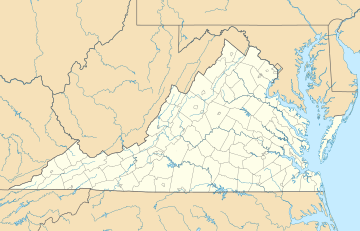Natural Bridge (Virginia)
|
Natural Bridge | |
 | |
|
The bridge, with a person below to indicate the size. Taken in 2005. | |
| Nearest city | Natural Bridge, Virginia |
|---|---|
| Coordinates | 37°37′39″N 79°32′43″W / 37.62750°N 79.54528°W / 37.62750; -79.54528Coordinates: 37°37′39″N 79°32′43″W / 37.62750°N 79.54528°W / 37.62750; -79.54528 |
| Governing body | Private |
| NRHP Reference # | 97001401[1] |
| Significant dates | |
| Added to NRHP | November 18, 1997 |
| Designated NHL | August 6, 1998[2] |
Natural Bridge in Rockbridge County, Virginia, is a geological formation in which Cedar Creek (a small tributary of the James River) has carved out a gorge in the mountainous limestone terrain, forming a natural arch 215 ft (65.532 m) high with a span of 90 ft (27.432 m). It consists of horizontal limestone strata, and is the remains of the roof of a cave or tunnel through which the creek once flowed. Natural Bridge has been designated a Virginia Historic Landmark and a National Historic Landmark.
Contents
[show]
History[edit]

The Natural Bridge was a sacred site of the Native American Monacan tribe, who believed it to be the site of a major victory over pursuing Powhatans centuries before the arrival of whites in Virginia.[3]
In March of 1742, a frontiersman named John Howard — along with his son and others — was commissioned by Governor Gooch to explore the southwest of Virginia as far as the Mississippi River. The party followed Cedar Creek through the Natural Bridge, then floated in buffalo-skin boats down the New, Coal, Kanawha, and Ohio Rivers to the Mississippi.[4]
Some believe that George Washington also came to the site in 1750 as a young surveyor on behalf of Thomas Fairfax, 6th Lord Fairfax of Cameron.[5] To support claims that Washington surveyed the area, some tour guides claim the initials "G.W." on the wall of the bridge, 23 ft. up, were carved by the future president. Legend also has it that George Washington threw a rock from the bottom of Cedar Creek over the bridge. In 1927, a large stone was found, also engraved "G.W." and bearing a surveyor's cross, which historians accepted as proof that he indeed surveyed the bridge.[6]
Thomas Jefferson purchased 157 acres (635,000 m²) of land including the Natural Bridge from King George III of England for 20 shillings in 1774. He called it "the most Sublime of nature's works". Jefferson built a two-room log cabin, with one room reserved for guests, beginning its use as a retreat. While President, in 1802, he personally surveyed the area. Many famous guests stayed here, including John Marshall, James Monroe, Henry Clay, Sam Houston, and Martin Van Buren.[6]
Natural Bridge was one of the tourist attractions of the new world that Europeans visited during the 18th and 19th centuries. Vacationing guests from all over the world took day trips from Natural Bridge on horseback or horse-drawn carriages to explore the countryside. In 1833, a new owner erected the Forest Inn to accommodate the increasing number of people.
The bridge had considerable notoriety during the 19th century. Herman Melville alluded to the bridge in describing Moby-Dick: "But soon the fore part of him slowly rose from the water; for an instant his whole marbleized body formed a high arch, like Virginia's Natural Bridge..." William Cullen Bryant, another American literary figure, said that Natural Bridge and Niagara Falls were the two most remarkable features of North America.[citation needed] During the 1880s Natural Bridge was a resort owned by Colonel Henry Parsons, who also owned the nearby Rockbridge Inn.[7]
In 1927 a nocturnal lighting display of the arch and gorge was designed by Samuel Hibben and Phinehas V. Stephens, illuminating engineers with the Westinghouse Company.[8] The display was formally switched on by President Calvin Coolidge in a 1927 inaugural ceremony. The original display has since been replaced with a sound and light show depicting the seven days of the Creation as described in Genesis.
On 12 May 2014, Governor Terry McAuliffe officially accepted the deed to Natural Bridge, transferring its ownership to the Commonwealth of Virginia. Plans are currently in place to have the site designated as a state park within the coming years.[9]
Present[edit]
Today, in order to view the bridge from below, a ticket needs to be purchased $20 for adults, youth ages 7–17 are $12 and children 6 and under are free. U.S. Route 11 (Lee-Jackson Hi-way) runs on top of the Bridge. However, due to the fact that the road runs across the naturally created bridge, little besides the roadway can actually be seen from the top as protective fences at the top block any potentially scenic view.
Following the trail under the bridge, in addition to seeing it from its less-often-photographed side, the visitor can walk some distance to the end of that trail; beyond the trail visitors can also view "Lace Falls", the remnant of the waterfall that helped to form the bridge. The "Saltpeter Cave" is located along the Cedar Creek Trail. The famed "Lost River" is marked along the trail where water was transported through pipes to the kettles used to extract nitrate. Gunpowder and ammunition were made for the War of 1812 from the Saltpeter Cave.
Natural Bridge is also the name of the town in which the bridge is located.
'Virginia' 카테고리의 다른 글
| First Battle of Bull Run (0) | 2015.05.29 |
|---|---|
| Manassas National Battlefield Park (0) | 2015.05.29 |
| Appomattox Court House National Historical Park (0) | 2015.05.29 |
| Winchester National Cemetery (0) | 2014.05.28 |
| Mount Hebron Cemetery, Winchester, VA (0) | 2014.05.28 |




